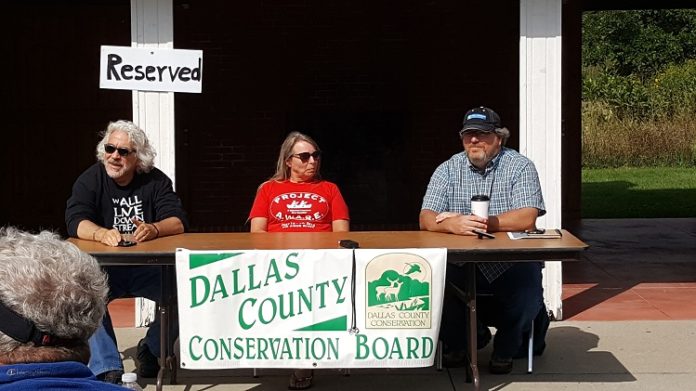
If you think of Iowa’s rivers and lakes as a patient on a sickbed, then Saturday morning’s discussion between three notable doctors of water health found them in general agreement on the cause of the patient’s disease but sharply at odds over how best to cure it — regulatory mandate or voluntary compliance — and differing on whom should pick up the tab.
The water-health experts taking part in Saturday’s 90-minute consultation at the Hanging Rock Nature Area in Redfield were Bill Stowe, CEO and general manager of the Des Moines Water Works, Roger Wolf, director of environmental programs and services for the Iowa Soybean Association (ISA) and executive director of the Agriculture’s Clean Water Alliance, and Mary Skopec, research geologist and director of the Iowa Department of Natural Resources (DNR) beach monitoring program.
“We have problems,” said Wolf, a 15-year veteran of the ISA. “We do have problems. We’re working to address those problems.”
Iowa’s problems include the worst surface water quality in the U.S. The DNR’s 2015 list of impaired waterways numbered 725, a 132 percent increase from the 313 impaired waterways listed in 2004.
Iowa’s lakes and streams are swimming in suspended soil particles, ag fertilizers, e coli bacteria and other pollutants, including poisonous blue-green algae.
Skopec illustrated the problem of blue-green algae toxins by describing a recent telephone call she received from a man who asked whether his grandchildren would be safe swimming at Lake of Three Fires State Park in southwest Iowa.
“I told him,” Skopec said, “‘From a state-beach perspective, there isn’t really a beach I would go to in southern Iowa right now.’ And he said to me, ‘Are we doing this to ourselves? Are we doing it?’ And I try to walk that line as best I can, but the answer is: Yes, we’re doing it to ourselves.”
Stowe put the matter even more bluntly: “We use our rivers as an open sewer,” he said. “That’s got to stop.”
Nitrate pollution has been the “topic de jure,” as Stowe called it, since the Des Moines Water Works sued three northwest Iowa counties in 2015, arguing underground field tiles act as conduits carrying nitrates into the Raccoon River, a prime source of drinking water for the utility’s 500,000 customers.
The water works also set a record in 2015 for the number of days it operated its nitrate-removal equipment, at a cost to its customers of $1.5 million.
“We’ve had the world’s largest denitrification facility for 25 years — 25 years! — and it’s too small because we’re seeing more nitrate come down the rivers,” Stowe said Saturday. The high contamination levels could soon force the utility to build a larger nitrate removal plant at a cost as high as $180 million, he said.
According to the Iowa Nutrient Reduction Strategy, unregulated agricultural land practices account for 92 percent of the nitrate pollution in Iowa’s waterways. Farmland takes up about 31 million acres of the state’s total of 36 million acres. Of the 2.3 million acres in the Raccoon River watershed, 1.7 million acres are in row-crop agriculture, according to Wolf.
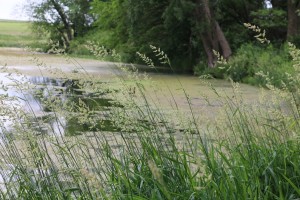
Along with nitrogen, phosphorus is now causing “a problem that is very emerging to us,” Stowe said, in the form of toxic blue-green algae. “We’re seeing more of it in Iowa’s rivers,” he said, “and we’re talking about parts per billion, fractions of parts per billion that create a public health concern. That isn’t about building a bigger plant and doing more denitrification. That’s a whole different concern now.”
Skopec said small amounts of dissolved phosphorus, previously ignored in studies of soil erosion and water pollution, now appear to be playing a large part in the formation of blue-green algae blooms.
Soil-erosion studies “always focused on total phosphorous, that particle-bound phosphorus,” Skopec said, “and what we’re finding now is tiles also move dissolved phosphorous, the part that we’ve not worried very much about because we think that if we stop the sediment, we stop the phosphorous.”
More recent research shows “that we need to stop all of that kind of water with its nutrients getting into our aquatic resources,” she said. “I think the things we’ve done have stopped a lot of soil erosion, but we haven’t been good at keeping the nutrients out, and now we’re seeing those blue-greens being driven by that dissolved component of phosphorus that even at a much lower number is very much driving those blue-green algae blooms.”
As a representative of the agricultural commodity producers who appear to be the state’s biggest polluters, Wolf looked like an easy target in the face of the evidence, but the 60 people who attended the event were far from hostile in their questions.

One audience member even praised Wolf simply for admitting the problem and not denying it or trying to shift responsibility, as growers and their defenders sometimes do, onto leaky septic systems or municipal wastewater treatment plants or the lowly Canada goose.
“Roger, the Soybean Association’s been way more positive in this regards,” said DNR Division Administrator Ken Herring. “In fact, you said here today that we have a problem. A lot of agriculture just doesn’t want to admit it but in order to solve a problem, first you’ve got to agree that there is one.”
Wolf noted he has collaborated with the Des Moines Water Works in water-monitoring efforts since 1999. He did not minimize the current problem of water pollution in Iowa and agriculture’s role in it.
“Think of a mountain. That’s the challenge we’re owning,” Wolf said, “a mountain, a hurricane. The scope and scale of treatment that’s going to be necessary upstream is immense.”
Wolf said water-quality issues — from nitrates in the Raccoon River to the Dead Zone in the Gulf of Mexico — “are more complex than people have time to think about, but the truth of the matter is we can apply technology. We can apply science and technology. The science is in. We know how to do this.”
Wolf called for “a national watershed approach” in addressing Gulf hypoxia and a similar watershed-level approach to Iowa’s pollution problems. He said the Iowa Nutrient Reduction Strategy needs “to mature out of a demonstration phase and into a scale-up phase. Can that be done voluntarily? I believe it can, and in fact I believe it has to be done that way because we need the flexibility to go into these communities and figure out how to finance them.”
The cost of cleaning Iowa’s water needs to be shared, Wolf said.
“This all has to be financed by somebody,” he said. “The farmers have some skin in the game, and society is going to have some skin in the game as well. We have some work to do in terms of advancing that scale up.”
Calling voluntary environmental protection “a prescription for failure,” Stowe reminded the audience that cleanup costs have thus far been paid entirely by consumers of clean water.
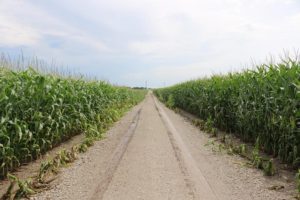
“What we’re talking about is stopping the shifting of production costs in corn and soybeans to downstream consumers,” Stowe said. “That’s exactly what’s going on right now. You as water consumers are paying to clean it up because the producers are pushing that cost to you. That’s not sustainable. You know it, and I know it.”
Wolf emphasized a common and collaborative effort. He said he was “asking for the people of Iowa to get serious about sharing in the investment it’s going to take.”
In reply, Stowe staked out a position where “safe, affordable, abundant drinking water is a basic human right. It doesn’t mean that it’s free. It doesn’t mean that when we say that, we have to say, ‘Pretty please, give us the water in a condition that we can deal with it. Let’s all be collaborative for decades and get nowhere.’ It means it’s basic human right.”
To believe that the problem can be solved “by voluntarily talking more about the problem is, I think, pushing on a rope,” Stowe said. “Ultimately, the issue, and Roger’s hinted at it several times, is who’s going to pay to clean it up.”
Wolf said he would like to see the ISA “walk together with Des Moines Water Works. We should have a treatment plant that is affordable and efficient and that meets the drinking water standards. Help us raise the money to go upstream and be successful. It should be a shared investment. That’s what I’m advocating for. We have work to do.”
“The problem is the production system is broken,” Stowe said. “There’s no accountability. This issue is bigger than nitrate. And right now, unfortunately, we’re finding the breadth of how big it is with something that’s relatively unknown to us in this blue-green algae that creates a toxin.”
The differences of opinion between the water-quality experts were not reconciled, but they were at least well aired.
Chris Adkins, the environmental education coordinator with the Dallas County Conservation Department who arranged Saturday’s conversation, had opened the program by presenting the audience with a half-gallon of untreated Raccoon River water and offering them a drink.
“Why is it that we accept the notion so calmly that you cannot drink this water?” Adkins said.
Skopec, who along with her DNR job also directs the IOWATER program, a volunteer water-monitoring program, rounded out the morning autopsy by alluding to the caller who asked her, “Are we doing this to ourselves?”
“The question you guys need to ask is how can we undo this to ourselves,” Skopec said to the listeners. “How are we going to live in this state where we can go to the beach, can swim in the water, we can have good aquatic life, we can have healthy fish and other organisms around here?”
Keep the Perry-area nature news coming with a $5-per-month donation to ThePerryNews.com. To get started, simply click the Paypal link below.








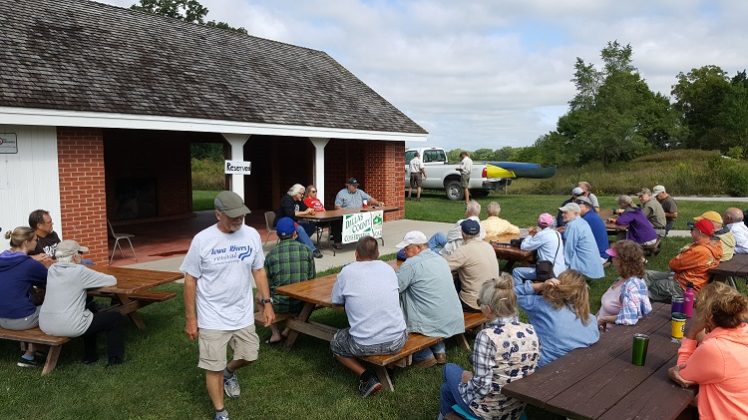
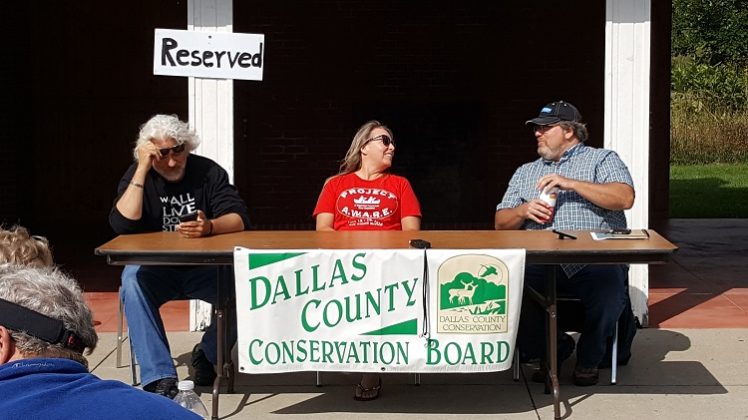
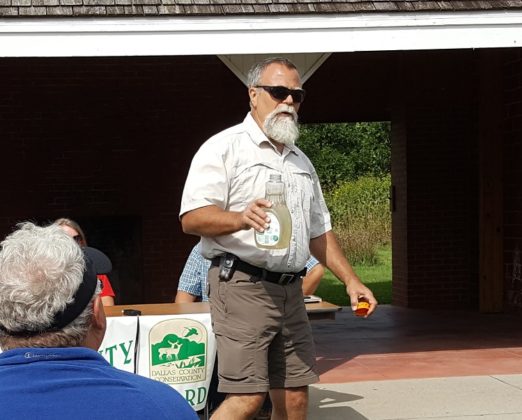
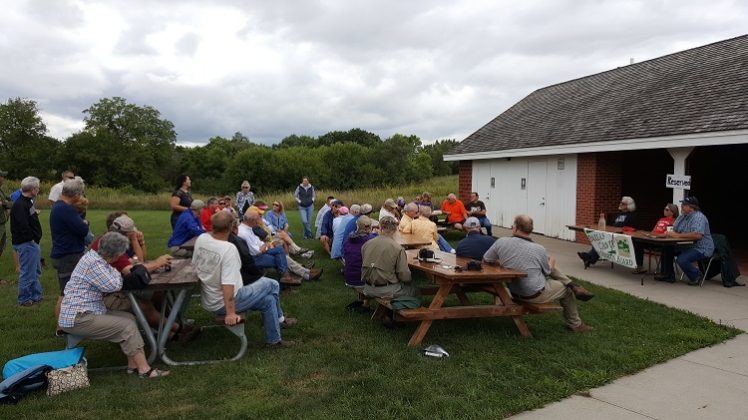
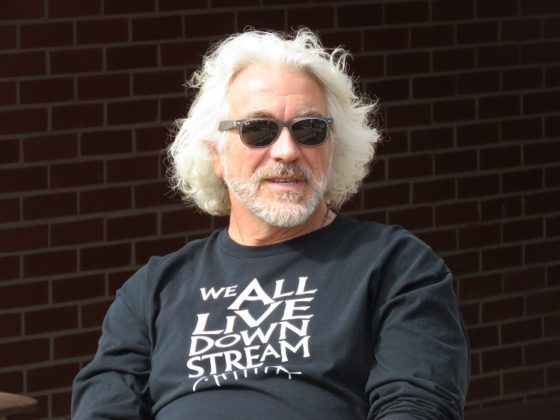
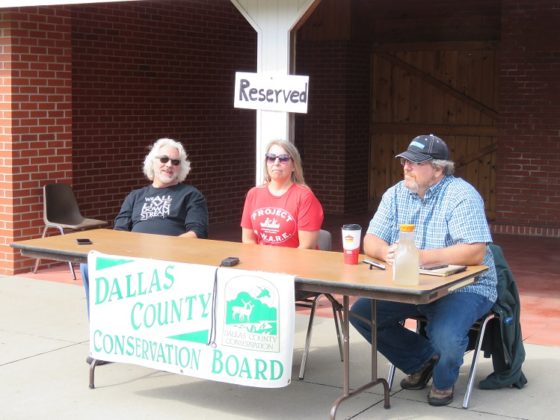
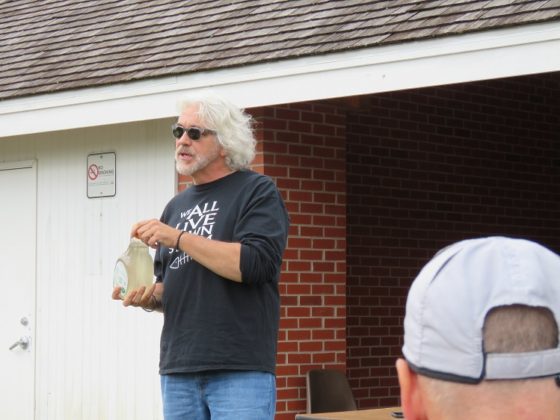

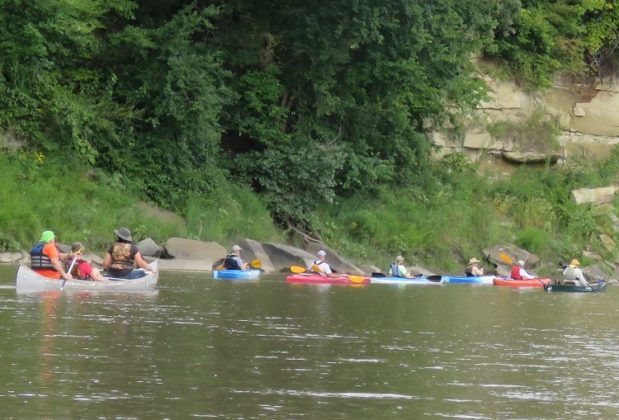
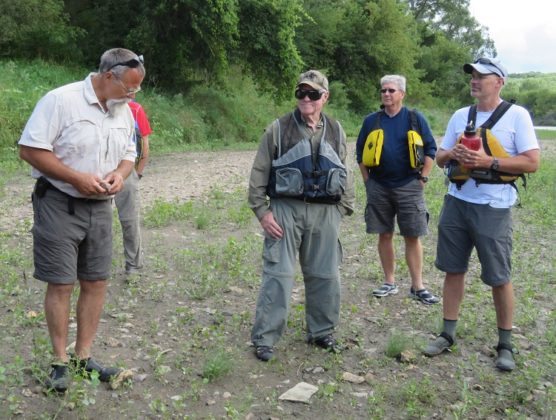








When I miss an event I wanted to attend, it’s great to be able to read full coverage of that event at ThePerryNews.com and feel as if I did attend. Thanks!
Go to http://www.IowaColdCases.org and look up my son Adam M. Lack, who was killed so his USDA-NRCS RUSLE III expanded (covering both CAFO and anhydrous ammonia nitrogen fertilizers) equation for evaluating a farm for a farmer’s IDNR Nitrogen Fertilizer Application Permit could not be used to limit the Point Source Polluting of these two very water soluble nitrogen fertilizers that feed the algae toxins we are drinking or are disgusted by in our surface water and our aquifers.